Netta Shalgi, Owner of Dynamic Design Studio (Israel)
What does an industrial product designer at Intel Corporation do when he’s away from silicon? He’s designing awesome wooden horses and launching them on Kickstarter!
I especially enjoyed working on this interview – I have been designing wooden toys for more than six years for CNC machines at CNCKing.com and here’s a guy who has all that knowledge and then some… doing his work by hand! He has his reasons, as you’ll read but this entire experience has taught him many valuable lessons in mass-by-hand-production.
His personal website is http://NettaShalgi.com while his Kickstarter campaign can be found at http://www.kickstarter.com/projects/netta/my-wooden-horse.
What aspects of design give you and your brother so much passion? Where does this drive to create and share come from?
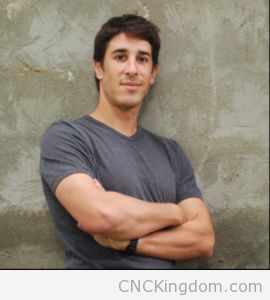 We both have always been attracted to the mechanic and industry fields. As kids, we were fascinated from the great man made technological and architectural achievements, such as skyscrapers, planes, cars, bridges, trains, etc.
We both have always been attracted to the mechanic and industry fields. As kids, we were fascinated from the great man made technological and architectural achievements, such as skyscrapers, planes, cars, bridges, trains, etc.
As kids we had a fleet of tractors, bulldozers, and cranes. We became very passionate (some might even say obsessed) with Lego Technic. We could first express our creative ideas via Legos by creating whatever came to our minds. Although we had many Lego Technic kits, we hardly ever used the step-by-step guides in favour of creating our own planes, engine models, etc. We even used to take pictures of our finished products, which we send to the Lego corporate headquarters as suggestions for new toy models for the company.
Another major aspect of our background that inspired us was the interface and inspiration from nature. We grew up in Israel on a Kibbutz, a collective community based on agriculture. This kind of rural environment with its proximity to livestock, woods and nature was a great place to observe and to become inspired by.
Combining our passion for mechanics and observation with our background inspired from nature led us to the understanding that we can redesign our surroundings and improve stuff. When we had to choose our academic path, it was quite clear that industrial design was the perfect match!
Where did the idea for a wooden horse come from and what made you want to jump onto Kickstarter to make it happen? Why not indiegogo or a host of other crowdsourcing sites?
Growing up on a farm, we came to love and admire horses, so in my (Netta’s) first year at university in his Woodshop class, he chose to create a wooden horse. The original piece was inspired from the auto-motor industry, especially by the Jaguar and Ferrari. The complicated surfaces, sexy curves and flowing shape were the features I wanted to plant in a wooden horse as a way of taking it out from the children’s world to and into the adult world as a kind of “wooden toy for the adult.”

The wooden horse has been with us since then (more than 9 years) and has become our trademark. Along the years, many people have asked us to make one for them but due to its complicated nature (more than 40 individual pieces in total), expensive materials, and the fact it is completely handmade, it wasn’t feasible for us to be able to meet the demands. That’s where kickstarter comes in. With funding through kickstarter, we will have the financial resources to get a production line going.
Once we decided My Wooden Horse needed to be mass produced, we changed some aspects of the horse to make it suitable for this new way of production.

We have known about Kickstarter and indiegogo for quite some time now, and during 2013 we signed up and started to back projects on both sites to get to know the crowd-funding world.
Netta also had some previous experience with crowd-funding sites with his work as a designer in a project called “angle,” a sensor platform that was successfully funded on Indigogo in 2012: http://www.indiegogo.com/projects/angel-the-first-open-sensor-for-health-and-fitness
We chose Kickstarter since it is the crowd-funding platform is more arts and crafts-focused then indiegogo (which is more technology oriented) and Kickstarter’s demands for the industrial design category met our approach.
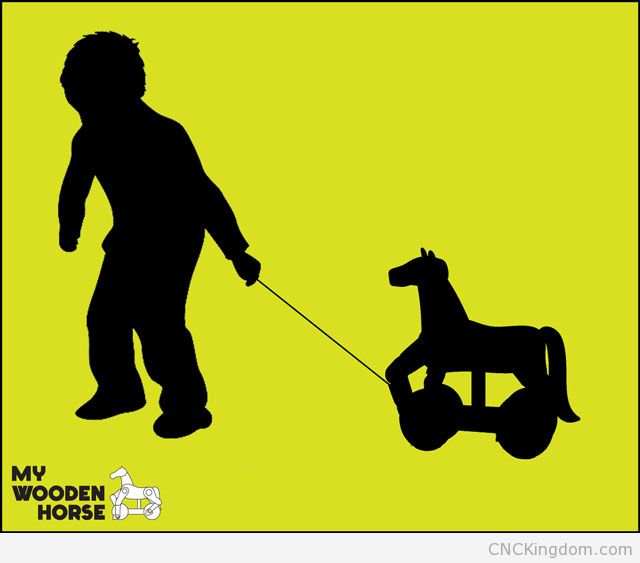
I have to mention that Kickstarter has been great because all of the campaign aspects of production and logistics must be considered prior to launching, and every gap must be taken care of.
It is a very informative experience from all aspects. For example, we had to work out the shipment and weight issue: each horse weighs nearly 4 pounds. We had to explain many backers why shipment price is high in comparison to other products on Kickstarter.
Each ones of your wooden horses is handmade – I have to ask… if you want to bring production prices down, why not automate most if not all the cutting using a CNC router? You could put in a full-sheet and in half an hour, have hundreds of parts ready to be shipped!
Well, it is sounds easy: why not just use machinery?
The first product was hand-crafted but designed totally by CAD, since we had to refine the proportions and lines–an action that is popular in vehicle design, using clay models. When we had the final parts as CADs we used those to cut some of the pieces by CNC, but making the whole sculpting was too expensive, as well as preset and calibration the machines for 2 sides. Therefore eventually, even when the outline is CNC cut, in order to get the surface quality to reach the “wooden touch,” many more hours of hand-sanding is still required. CNC can’t totally replace the human finish, but it certainly can shorten most of the process.

I’ve designed over 250 CNC projects across laser, router and 3D printers… what are some of the challenges you found with your horse that you could have improved upon and why a horse in the first place? Why not a tractor, a pig or a barn?
We are inspired by horses. The newest and most avant-garde motors in the world such as Bugatti veyron, Konningseg are all still measured in “horse power.” It is timeless. A horse is a noble animal. It has something majestic, royal. The pose, muscle structure, is so impressive, that if we had turn to do a pig, a tractor or a barn, we wouldn’t be able to create something so elegant. People have long had an infatuation with horses and the wooden horse became a popular object to have.
Even people who did not grow up around horses as kids still find My Wooden Horse an object to enjoy and cherish as an adult. We’re all still kids at heart!
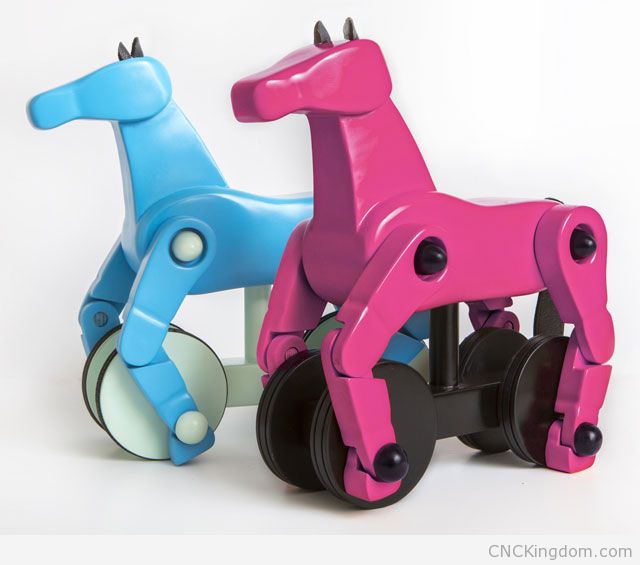
For the next model we are definitely going to change the sculpting orientation and the perception of how to build the large piece of the head-neck-body. We used to make it in several pieces and then in layers. Now we will make it in 2 halves, smoothing the parting line. It is the most simple and fastest to make.
Another change will be made in the way we connect the dowels. On previous models the holes went all the way through the legs and wheels and therefore needed a complicated surface treatment, since the fibers ended up in two different directions, which would then cause sink marks to appear while painting. In future models, we won’t drill the legs all the way, which will leave the external surface smooth. We checked that the width is thick enough even if we don’t drill all the way to the bare dowel.
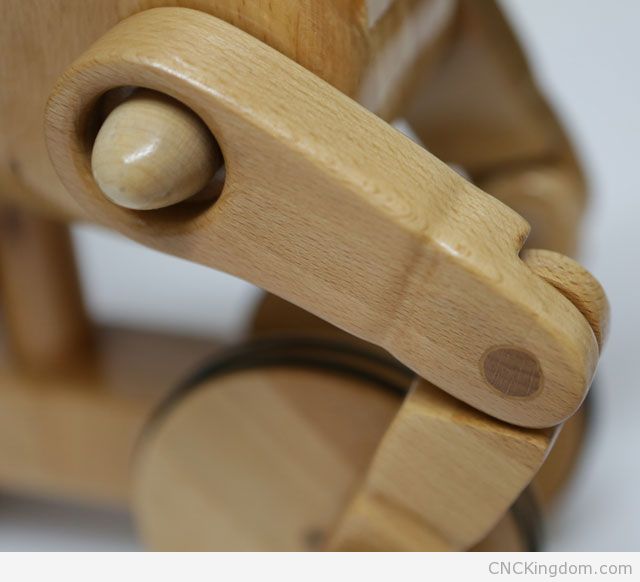
The one issue I have with your design, which I discovered after making about 20 CNC designs, is that you used round wooden dowels. I REALLY wish dowels were consistent but they aren’t in diameter especially when matched against the precision of a CNC machine. I was wondering what kind of variance you were experiencing with the dowels in this project. Have you had to sand some down or play with the variance of your holes to suit individual dowel diameters?
We thought we would have problems with the precision, but we found they actually inserted quite accurately. We made the wheels’ hole in a precise diameter, which we then sanded just enough to allow the dowel to slide in with the correct amount of friction. The glue and the pressure hold everything tightly while still allowing for it to roll easily. The first model was made 9 years ago (2005) and still works perfectly today. We also tend to use harder wood for the dowels.
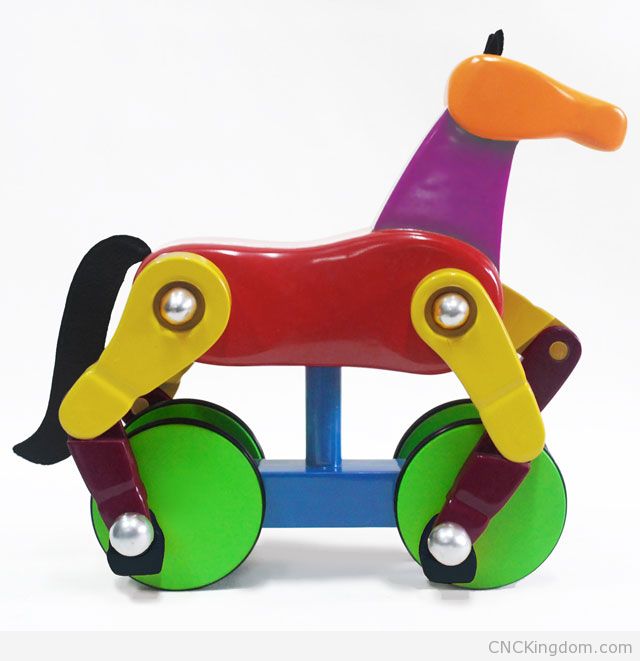
I really like the paint you are using on your designs, what is your painting process and how do you get such a deep and rich color out of them after drying?
In order to get a good paint result, we must give the surface a very good and intense preparation. We treat all surface defects and make sure the surface is smooth and consistent. Then we paint a primer layer that connects the paint to the wood and also covers surface defects. if needed we treat those defects and repeat the process. We never rush, and we leave it all to dry as much as needed, which prevents cracking and bumps on the surface later on. It could appear even after a year or two. For painting we use a very high-quality car paint, which we get in any shade we want.
We tend to use paint with a lacquer already mixed inside. We find this to be less messy, a time saver and in the end the result is better. For some time we used to do them separately, but in some cases the lacquer may make the color dull and not as deep as we intend. We apply two layers and were done.

You went to the Holon Institute of Technology to get your degree in industrial and production design. How does the knowledge you acquired during the course of your studies help you with the production schedule for this project and designing in general?
I (Netta) went to the HIT (Holon intestate of technology) and Avner (brother) studied at Betzalel Academy at the Hebrew University in Jerusalem. We both studied the same degree and both have the same passion for design. Although the same degree, the two institutes are totally different in the application and approach of the discipline.
Holon is much more “industry” oriented and Betzalel is known for its strong aesthetics development. In terms of the schedule and production of My Wooden Horse, I must say that the academic knowledge doesn’t really match up to what you meet later on in your work as a designer. And it shouldn’t.

As a student you need to get the skills to design, not to run a business or project as a designer. Only at our work, after we finished our academic degrees, was when we really dealt with production, schedules, manufacturing, quotation, QA and every other action regarding production. Now we’re concerned with marketing for the first time.
I must say that I find it as thrilling as I do designing. I realize that you can be creative no matter what field you’re working with. I’m quite surprised that the creative process of design has many solutions for issues in other fields. And this is where our sister, Amit, enters the picture.
She is younger but smarter! She is an advertising specialist who studied marketing and communication. She drives the marketing and lots of our crazy concepts forward. We’re all in the business together.
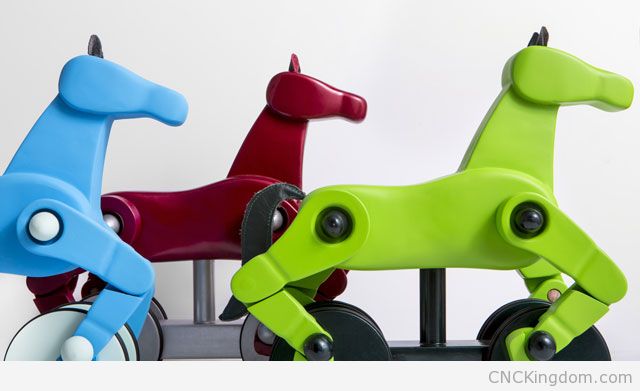
Anything else you’d like to add?
We try to learn, to keep our minds open and take something from every interface we have. Regarding the project and in general, we realize that eventually it’s not the horses, it’s the people in the system. We understand the responsibility of making a high-quality toy for people who paid good money for it and trust what we offer. We take that responsibility with honor.

